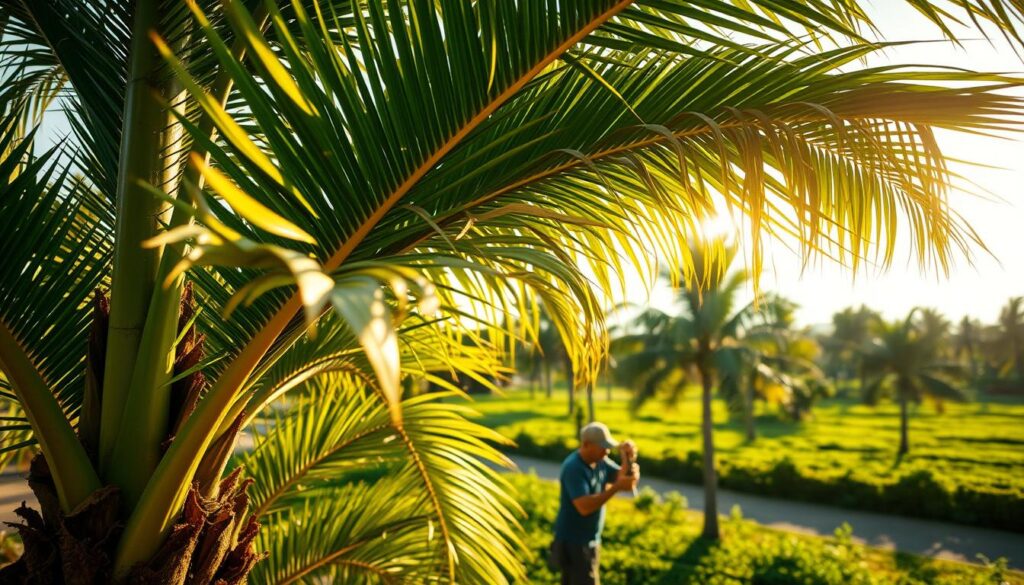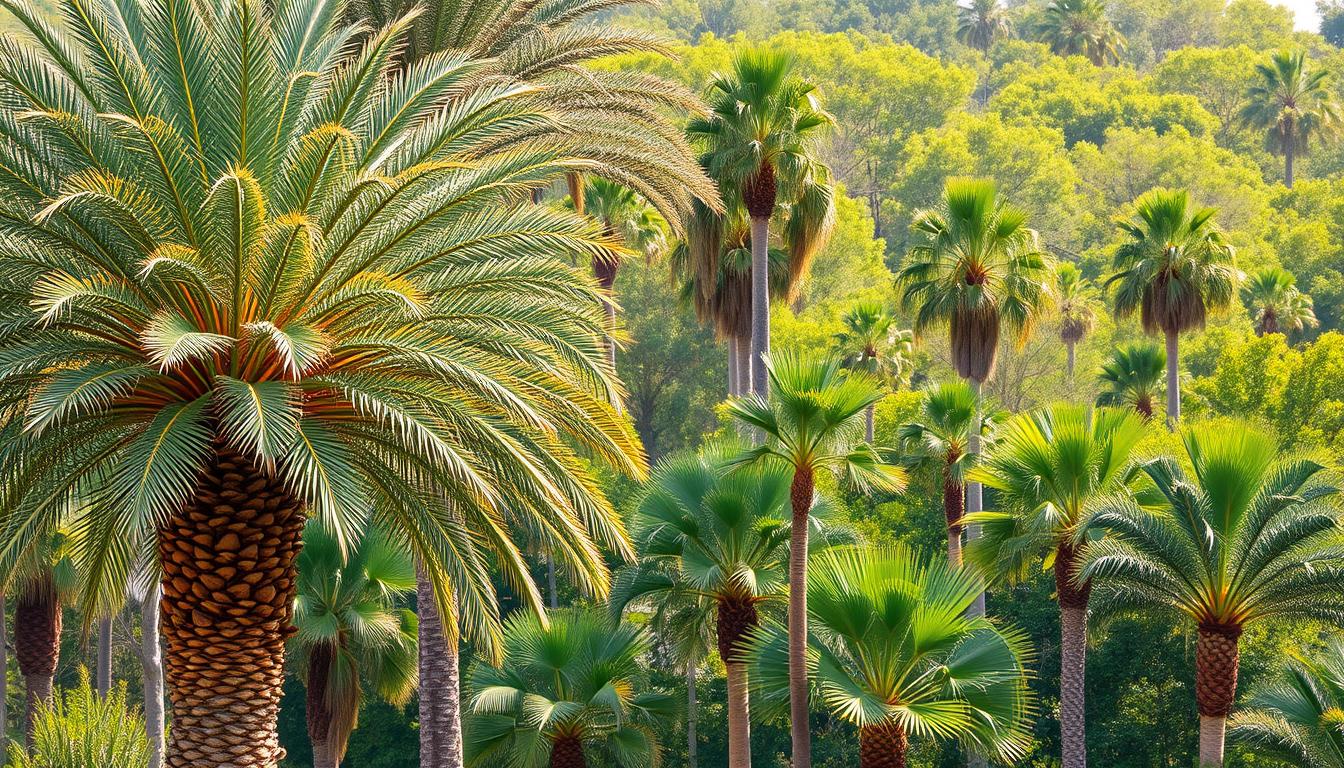Imagine standing under a tall palm tree, feeling the warm breeze on your skin. These plants have amazed people everywhere, changing landscapes from beaches to city gardens. They are more than plants; they are nature’s art, connecting us to the world around us.
Palm trees are part of the Arecaceae family, with about 2,600 different types. If you love tropical gardens or just enjoy nature, learning about these trees is exciting. They show us the beauty of nature and how we can use it in our gardens.
Palm trees fit any space, from small indoor plants to big outdoor ones. Their long trunks and wide leaves make them easy to spot and love. They look great in many places, from beaches to cities.
Table of Contents
Understanding Palm Trees and Their Characteristics
Palm trees are a fascinating group of tropical plants. They have unique traits that make them stand out. These plants can grow in many places, from rainforests to dry lands.
Palm trees come in a wide range of sizes and shapes. Unlike regular trees, they grow from a single point. This means their trunk size stays the same once it’s formed.
Physical Features of Palm Trees
Palm trees have distinct features that make them easy to spot. Their main traits include:
- Unbranched trunks with a single growing point
- Large, fan-shaped or feather-like leaves called fronds
- Unique root system concentrated at the base
- Smooth or textured bark with varying colors
Growth Patterns and Requirements
Each palm tree variety grows differently. Some grow as single-trunk plants, while others form clusters. Knowing what each needs is key to growing them well.
| Palm Variety | Mature Height | Growth Rate | Climate Preference |
|---|---|---|---|
| Coconut Palm | 50-100 ft | 1-3 ft/year | Tropical |
| Pygmy Date Palm | 5-10 ft | Slow | Subtropical |
| Mexican Blue Fan Palm | 20-40 ft | Moderate | Warm temperate |
Natural Habitats and Distribution
Tropical palms are incredibly adaptable. They thrive in many places, from rainforests to coastal areas and even deserts. This adaptability is why they’re found all over the world.
Learning about these plants shows their complexity and beauty. It’s no wonder palm trees fascinate botanists and garden lovers everywhere.
Types of Palm Trees: Essential Classifications
Learning about palm tree identification is key to picking the right one for your yard. There are over 2,500 types of palm trees found in warm and subtropical areas around the world.
Palm trees fall into several main categories. This makes it easier to choose the right one for your needs:
- Growth Type Classification
- Climate Adaptability
- Landscape Purpose
When looking at popular palm trees, you’ll see two main types of growth:
- Single-Trunk Palms: These have one main trunk and add height to your space
- Clustering Palms: They have many stems from one base, creating a full look
How well a palm tree adapts to the climate is very important. Some palms love warm weather, while others can handle cooler temperatures. For example, the Windmill Palm can even survive temperatures as low as 10°F. This makes it great for cooler areas.
| Classification Type | Key Characteristics | Example Species |
|---|---|---|
| Single-Trunk | Vertical growth, one central stem | Mexican Fan Palm |
| Clustering | Multiple stems, dense growth | Lady Palm |
| Tropical | Warm climate preference | Queen Palm |
| Temperate | Cold-hardy varieties | Windmill Palm |
When choosing a palm tree, think about its growth, climate needs, and how you want it to look in your yard. Knowing these details helps you pick the best palm tree for your outdoor space.
Popular Indoor Palm Species
Indoor palm trees are a top pick for adding tropical charm to homes and offices. They bring lush greenery and adapt well to indoor spaces. Whether you’re a seasoned plant lover or new to greenery, indoor palms have something for everyone.
When picking indoor palms, think about light needs, growth, and upkeep. Here are some top picks for indoor spaces:
Parlor Palm (Chamaedorea elegans)
The Parlor Palm is a favorite for indoor spaces. It can grow up to 6 feet tall. It’s known for being:
- Non-toxic, safe for pets
- Good with low to moderate indirect light
- Compact, perfect for small areas
Kentia Palm (Howea forsteriana)
The Kentia Palm is elegant and can reach 10 feet with the right care. It’s great for indoor spaces because it:
- Does well in low to bright indirect light
- Thrives in moderate temperatures
- Handles limited direct sunlight well
Lady Palm (Rhapis excelsa)
The Lady Palm is known for its toughness. It’s great for indoor growing because it:
- Can handle irregular watering
- Is less likely to get pests
- Does well in low to moderate indirect light
When picking an indoor palm, think about your space, light, and care level. Each palm species adds its own beauty to indoor spaces.
Majestic Outdoor Palm Trees
Turn your yard into a tropical paradise with stunning outdoor palm trees. These plants add elegance and drama to any garden. They create breathtaking views that feel like exotic places. When picking palm trees, choose ones that do well in your climate and soil.
Some outdoor palm trees stand out for their unique qualities:
- Washingtonia robusta (Mexican Fan Palm): Known for its tall, slender profile
- Sabal palmetto (Cabbage Palm): Extremely resilient in coastal regions
- Hyophorbe lagenicaulis (Bottle Palm): Compact and ideal for smaller spaces
When planning your palm trees, think about sunlight, wind, and growth. The Royal Palm, Coconut Palm, and Date Palm are great for dramatic looks in your yard.
Your choice of palm trees depends on a few things:
- Local climate zone
- Available sunlight
- Soil drainage
- Space limitations
Understanding each palm’s needs is key to good landscaping. Some palms love full sun, while others prefer partial shade. By picking and placing your palms wisely, you can create a beautiful, easy-to-care-for outdoor space that feels like a tropical paradise.
Cold-Hardy Palm Tree Varieties
When we think of palm trees, we often imagine warm, tropical places. But, some palm trees can handle cooler weather, opening up new possibilities for your garden. These cold-hardy palms let gardeners in cooler areas enjoy their beauty.
Choosing the right palm trees for colder areas means knowing their special traits. These palms have learned to deal with cold and harsh weather in amazing ways.
Windmill Palm (Trachycarpus fortunei)
The Windmill Palm is a standout among palms that can take the cold. Native to central China, it can handle temperatures as low as 10°F. It’s known for:
- Mature height: 8-10 feet tall
- Width: 4-6 feet
- USDA Hardiness Zone: 7b
- Tolerates short periods of freezing temperatures
Needle Palm (Rhapidophyllum hystrix)
The Needle Palm is the most cold-resistant palm out there. It’s perfect for gardeners facing tough climates:
- Mature height: 3-6 feet
- Width: 4-8 feet
- USDA Hardiness Zone: 6
- Can survive temperatures down to -10°F
European Fan Palm (Chamaerops humilis)
This small palm adds a touch of Mediterranean flair to cooler gardens. Its ability to handle the cold makes it a top choice for landscapers:
- Mature height: 8-15 feet
- Width: 6-10 feet
- USDA Hardiness Zones: 8-11
- Can tolerate temperatures as low as 5°F
“In the world of palm trees, cold hardiness is not a limitation, but an opportunity for creative landscaping.” – Landscape Design Expert
When picking cold-hardy palms, think about your garden’s specific needs. These tough palms show that you can have tropical beauty even in cooler places.
Tropical Palm Species for Warm Climates

Exploring tropical palms reveals a wide range of species that love warm, humid places. These plants add beauty and uniqueness to any landscape.
Some tropical palms are truly special because of their features and how well they adapt. Let’s look at a few that show off the beauty of tropical landscapes:
- Coconut Palm (Cocos nucifera): A classic tropical icon
- Foxtail Palm (Wodyetia bifurcata): Known for rapid growth
- Spindle Palm (Hyophorbe verschaffeltii): Distinctive bottle-shaped trunk
Tropical palms need certain conditions to grow well. They like temperatures between 70-90°F and lots of humidity.
| Palm Species | Mature Height | USDA Zones |
|---|---|---|
| Coconut Palm | 50-100 ft | 10-12 |
| Foxtail Palm | 20-30 ft | 10-11 |
| South American Queen Palm | 20-50 ft | 9-11 |
When picking tropical palms for your garden, think about space, sunlight, and climate needs. Each palm brings its beauty and benefits to warm gardens.
Choosing the right tropical palms can make your outdoor space feel like paradise. They create lush, lively areas that feel like a tropical getaway.
Palm Trees for Landscaping and Design
Planning your outdoor spaces? Palm tree landscaping is a great choice. It brings stunning visuals and tropical charm. Ornamental palms can turn your landscape into something amazing.
Choosing the right palm is key. You need to think about a few things:
- Growth potential and mature size
- Climate adaptability
- Aesthetic requirements
- Maintenance complexity
Poolside Palm Options
For poolside areas, pick palms that don’t drop much debris. They should also have small root systems. Here are some good options:
- Pygmy Date Palm (Phoenix roebelenii): Grows 5-10 ft tall, perfect for smaller spaces
- Christmas Palm (Adonidia merrillii): Reaches 3-25 ft tall, adds elegant tropical touch
- Bottle Palm (Hyophorbe lagenicaulis): Matures at 5-15 ft tall, creates dramatic focal point
Privacy Screen Palms
Need a natural privacy barrier? Choose the right palms. The Areca palm and Mexican fan palm are great for this. They grow fast and have dense foliage.
Accent and Focal Point Palms
Want to make a statement? Try these ornamental palms:
- Canary Island Date Palm: Majestic 40-60 ft height
- Bismarck Palm: Striking silvery-blue fronds
- Queen Palm: Elegant tropical appearance
“The right palm can transform your landscape from mundane to magnificent.” – Landscape Design Expert
Successful palm tree landscaping needs knowledge. Understand each palm’s unique traits and match them to your environment.
Care and Maintenance Requirements

To grow palm trees well, you need to know their special care needs. Whether they’re inside or outside, keeping them healthy is key. First, you must understand what each palm tree needs.
Watering is very important for palm trees. New palms need extra care in their first year:
- Water daily for the first 2-3 weeks after planting
- Then, water deeply twice a week for 2-3 months
- Outdoor palms need water twice a month in summer and once every six weeks in cooler weather
- Indoor palms should be watered when the top 1-2 inches of soil feel dry
Fertilizing is also crucial for palm trees. Here’s what to do:
- Fertilize mature palms 1-3 times a year when they’re growing
- Use ½ to 1 pound of fertilizer per inch of trunk diameter
- Choose slow-release fertilizers made for palm trees
Keep an eye out for health problems in your palm trees. Issues like nutrient shortages and pests can happen. Look for signs like:
- Discoloration of fronds
- Stunted growth
- Wilting of older fronds
- Deformed new shoots
Keep your palm trees safe by making sure the soil is right. Most palms like a soil pH between 5.5 and 7.5. Use a potting mix with peat moss, leaf mold, and shredded bark for the best growth.
Conclusion
Exploring types of palm trees opens up a world of botanical diversity. You’ll find everything from small indoor palms like the Lady Palm to tall outdoor palms like the Royal Palm. These plants are perfect for any space and climate.
Popular palm trees do more than look good. They bring a tropical feel to any area. Whether you’re setting up a simple indoor space or a lush outdoor area, picking the right palm is key. Knowing what each palm needs helps you choose the best one for your vision.
Palm trees are not just for looks. They come in varieties that can handle cold or hot climates. This means you can bring exotic beauty to different places and weather conditions.
Choosing the right palm trees can make your outdoor and indoor spaces beautiful and easy to care for. Your exploration of palms is a chance to refresh your spaces with these amazing plants.
FAQ
What are the main characteristics of palm trees?
Palm trees have a single stem or trunk and large leaves at the top. They grow from a single point and don’t get wider after they start. There are different types, like single-trunk and clumping palms.
How many types of palm trees are there?
There are about 2,600 types of palm trees. They range from small indoor palms to big outdoor palms. You can find them in many places, like rainforests and deserts.
What are the best palm trees for indoor spaces?
Good indoor palms are the Parlor Palm, Kentia Palm, and Lady Palm. They do well in low light and indoor conditions.
Can palm trees grow in cold climates?
Yes, some palms can handle cold. The Windmill Palm, Needle Palm, and European Fan Palm can take temperatures below freezing.
How do I care for a palm tree?
To care for a palm, water it right and use special palm fertilizer. Keep it away from extreme cold and watch for pests. Each palm type needs different care, so learn what yours needs.
What are the most popular outdoor palm trees?
Outdoor favorites are the Royal Palm, Coconut Palm, Date Palm, and Foxtail Palm. They’re big, look tropical, and make great landscape features.
Are palm trees good for landscaping?
Palm trees are great for landscaping. They can be privacy screens, focal points, or pool decorations. Their shapes and sizes add to many garden styles.
How long do palm trees live?
Palm lifespans vary. Indoor palms might live 20-50 years. Outdoor palms like the Royal Palm can live up to 100 years with good care.
Do palm trees produce fruit?
Yes, many palms produce fruit. Coconut, Date, and Açaí palms are examples. These fruits are not just pretty; they’re also important in tropical economies.
How fast do palm trees grow?
Growth rates differ. Coconut Palms grow fast, adding 1-2 feet yearly. Needle Palms grow slowly, maybe just a few inches a year.

